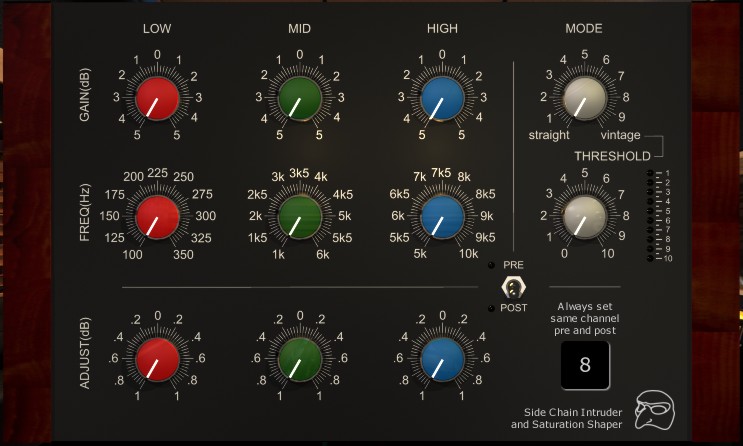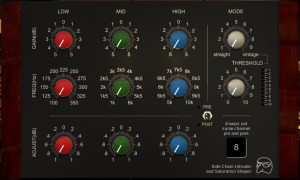One way to classify audio effects is to divide them in “linear” and “non linear”.
Linear effects can be chained in any order, the global result will be the same. Non linear effects care of insert order.
Examples of linear effects are: delay, equalization, reverb.
Examples of non linear effects are: compression, gating, saturation.
Analog devices (and modern digital emulations of them) are almost always non linear, because the behavior of the circuits departs from theory. Also linear effects can be non linear, like some reverbs.
Compression and saturation are always non linear, and they are what we mainly focus on here.
A compressor controls signal’s level measuring its amplitude and varying the gain according to settings. Its main use is to reduce the gain when the input signal is too strong. A compressor splits the input signal along two paths: audio and control (the “side chain”). The side chain is where the compressors decides how to control gain. What happens if the side chain is not transparent? It happens when we have so called side chain filters available. We equalize the signal in the side chain, fooling the compressor. If we boost a frequency region, the compressor will be more sensitive to that range. The audio signal won’t change but its dynamics will. We are introducing frequency dependence.
What if we have a beautiful compressor but the designer didn’t include sidechain filters? We can still fool the compressor and get infinite variations of its behavior, without affecting the frequency balance of the audio.
Just imagine to use an equalizer on the audio, before the input, and its perfect opposite after the output. The audio path (EQ -> compressor -> inverse EQ) is flat. The sidechain (EQ) isn’t. The so called emphasis -> de-emphasis technique.
The net result is the same as having that equalizer inserted in the side chain by the designer.
This is a tool that can do it, it is called “Fooler”. It fools the compressor.
Insert one before the compressor, another one after, set them to “pre” and “post” and they’ll take care of emphasis. Now you have a sidechain control for all your compressors!
Yes, you can do it yourself. Use your favourite equalizer (a simple one) before your compressor, the same one after and set them manually to always null. Always track pre settings with post unit when you change them.
But things start to get really interesting when the equalization is not static. That’s what happens with real gear. Everything has timing. And here is where Fooler becomes really special. Increase its “Mode” control from straight to vintage and things start moving.
Here is a simple preset, give your compressor some optical flavour:
- Pick your favourite compressor and insert Fooler pre and post. Engage auto compression mode if available. Attack: 140 ms. Release: 1 s.
- Low frequency: 250 Hz. Low gain: 3 dB cut.
- Mid frequency: 2 kHz. Mid gain: 1 dB boost.
- High frequency: 6 kHz. High gain: 2 dB boost.
- Mode: 7.
- Set the threshold to get the meter roughly departing from off with compressor’s meter.
Try it also with your hardware compressors.
Now, this is an interesting trick for saturation, too. More about it later.

